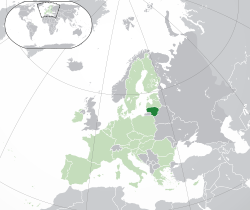Our website is made possible by displaying online advertisements to our visitors.
Please consider supporting us by disabling your ad blocker.
Municipalities of Lithuania
This article includes a list of general references, but it lacks sufficient corresponding inline citations. (November 2021) |


 |
|---|
|
|
 |
| Administrative divisions of Lithuania |
|---|
|
Counties Municipalities Elderships Sub-elderships |
| Geocodes of Lithuania |
|
|
Lithuania is divided into three levels of administrative divisions. The first-level division consists of 10 counties (Lithuanian: singular – apskritis, plural – apskritys). These are sub-divided into 60 municipalities (Lithuanian: plural – savivaldybės, singular – savivaldybė), which in turn are further sub-divided into over 500 smaller groups, known as elderships (Lithuanian: plural – seniūnijos, singular – seniūnija).
At the end of its tenure as a Soviet Socialist Republic, Lithuania's administrative divisions consisted of 44 regions, 12 cities, 80 towns, 19 settlements, and 426 rural districts.[1] The reform of this system was an immediate concern for the new government.[2] The Constitution of Lithuania, ratified in 1992, delegated the power of establishing future administrative units to the Lithuanian Parliament (Seimas). Accordingly, the Seimas passed two fundamental laws: a 1993 law on government representation and a 1994 law specifying the territorial-administrative units and their boundaries.[2] The current system of a set of municipalities under 10 counties was codified by 1995.[2] Several changes were made in 2000, resulting in 60 municipalities.[3]
Ordinary municipal councilors are elected every four years from electoral lists using proportional representation. The mayor, who used to be a member of the council until 2023,[4] is elected directly by the residents using the two-round system since 2015 reforms.[5] Before then, the mayors were elected by the municipal councils.
The largest municipality by population in Lithuania is Vilnius City Municipality with 593,436 residents, home to one fifth (20.7%) of the country's population. The smallest municipality by population is Neringa Municipality with 4,173 (0.1%) residents.[6]
The largest municipality by land area is Varėna District Municipality, which spans 2,216 km2 (856 sq mi), while the smallest is Alytus City Municipality at 40 km2 (15 sq mi).
- ^ Conference on Local and Regional Authority Co-operation in the Baltic Sea Area: proceedings, Kaunas, Lithuania, 21-23, April 1999. Council of Europe. January 2000. p. 9. ISBN 978-92-871-4538-3. Retrieved 16 February 2011.
- ^ a b c Jolanta Vaičiūnienė (2008-11-14). "The Administrative–Territorial Reform in Lithuania: History and Today" (PDF). Council of Europe. Retrieved 16 February 2011.
- ^ Local Economic and Employment Development (Program); Organisation for Economic Co-operation and Development (April 2007). Baltic partnerships: integration, growth and local governance in the Baltic Sea Region. OECD Publishing. p. 75. ISBN 978-92-64-02928-6. Retrieved 23 February 2011.
- ^ Skėrytė, Jūratė (14 March 2023). "Apžvalga: naujai išrinktiems merams – didesni įgaliojimai". LRT (in Lithuanian). Retrieved 20 March 2024.
- ^ "Law on elections to municipal councils". The Seimas of the Republic of Lithuania. Retrieved 31 July 2015.
- ^ "Resident population on 1 July". osp.stat.gov.lt. 2023-08-07.
Previous Page Next Page


